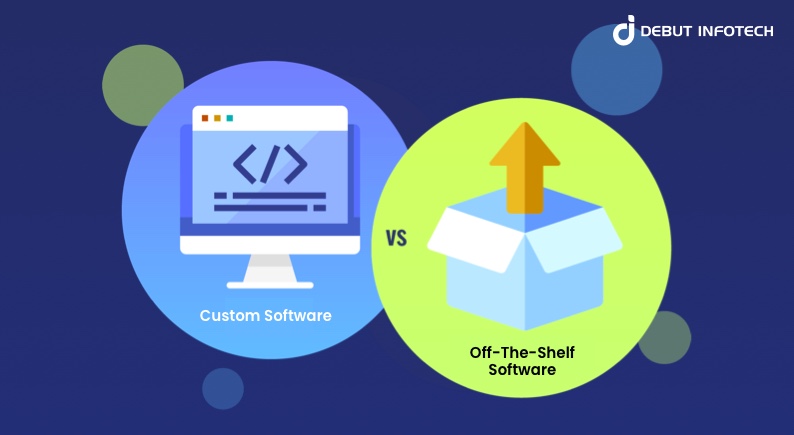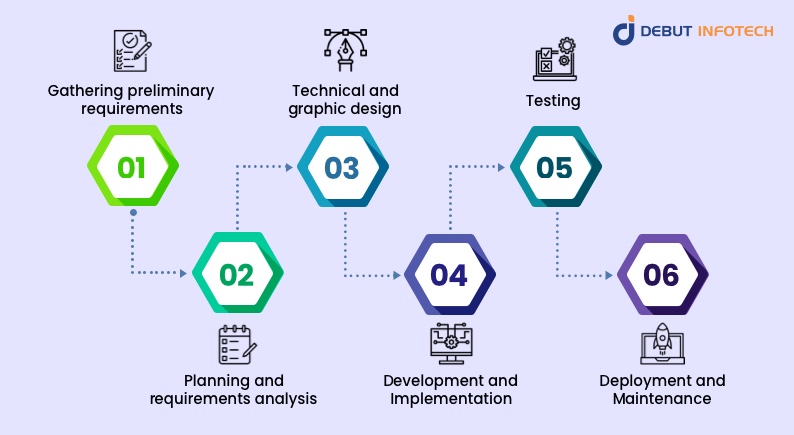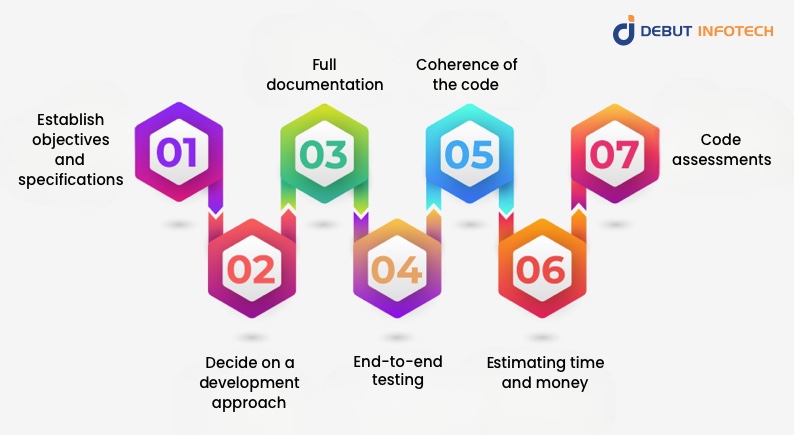Table of Contents
Home / Blog / Web Development
Exploring Custom Software Development Services
March 11, 2024

March 11, 2024
In today’s cutthroat market, creating software or an application that satisfies particular company criteria is essential for survival. Within an organization or as a third-party agreement, custom software development is the process of thinking, creating, building, and deploying software for a specific individual or group.
Custom software is more efficient than commercial off-the-shelf software (COTS) because it is designed to meet unique customers’ demands. COTS is appropriate for a larger audience because it targets a more diverse range of requirements. Businesses can include off-the-shelf software in their daily business activities by marketing and promoting it. Microsoft Office is among the best instances of off-the-shelf solutions because it can satisfy the general needs of a larger audience on a global scale.
That being said, not all business needs can be categorized. Teams and business processes have unique requirements that call for customized solutions. Herein lies the utility of custom software creation. Custom software suites include industry-specific e-commerce software for a faster buying experience or student portals with course modules.
Significant Differences Between Off-The-Shelf Software and Custom Software

Once installed on a computer or device, off-the-shelf software is immediately operational. On the other hand, custom software is created and tailored to fulfill particular needs.
There is a significant difference between these two technologies regarding performance, usability, and functionality. Every technology has advantages and disadvantages, which are summarized here.
Implementation
It’s getting easier and easier to code every day. Programmers used to run lines of code for weeks at a time. High schools teach coding to their students these days, and there are ever more open-source code snippets available for any feature. Integrated development environments (IDEs) offer intuitive drag-and-drop interfaces that enable the development of complex programs without the need to write code. A basic understanding of coding may enable the necessary adjustments quickly.
However, just because coding is simple doesn’t mean developing software is easy. The entire process of developing software involves more than just coding. UI/UX design, testing, upgrading, and requirement collecting are additional critical phases in the development process that call for qualified and experienced personnel. Creating custom software may seem doable despite the high skill level needed. Developmental tasks have the potential to divert businesses from their primary objectives. Development projects may impact the efficiency of internal IT resources since they are already active in routine maintenance.
Businesses using custom software may experience setbacks until the problems are resolved; this is how the program ultimately develops. Businesses can use off-the-shelf software to learn from the errors made by others.
In addition, off-the-shelf software developers employ agile and other best practices for software development, primarily focusing on the software itself. For a competitive advantage, they also keep up with new technological developments.
On the other hand, getting software off-the-shelf is not as easy as getting groceries from a store. An organization must still carry out the requirement-gathering process to identify the ideal product. The UX design, necessary infrastructure, device compatibility, and ease of use of even off-the-shelf software solutions must be evaluated. Furthermore, because you don’t own off-the-shelf software, it cannot grow with your business.
Integration
Enterprise-level systems must seamlessly integrate with the software for firms to maintain a competitive edge in this era of data analytics. Off-the-shelf software might not be able to interact flawlessly with other software systems in terms of integration options. Since custom software can be created and developed to allow for seamless integration, the additional time and money invested in its development may be justified. When designing the project’s blueprint, a software developer might consider the current system to ensure the new software integrates seamlessly with the existing IT ecosystem.
Scalability
One of the most important things to consider when choosing technology for your company is scalability. Your company should be able to handle both present and future needs with the software it needs. You may need to add additional features and functionalities as your firm grows. It makes sense to start software development in a scalable manner. Such functionality is not available in off-the-shelf software.
Upgrades
Without a doubt, off-the-shelf software offers excellent customer support. However, when they are not updated for a lengthy period, it can force you to utilize an outdated product that can harm your business. You can make any modifications you need to, whenever you want, with custom software. When creating custom software, you are in charge of deciding what new features and improvements to include. You can update your program with new features without waiting for new releases.
Custom software development is the best option if you’re looking for bespoke software to fulfill your unique business needs.
Pros And Cons Of Custom Software Development
Pros
- Unique responses to demands: Custom software is the best option for businesses because each has unique business procedures. It is made to accommodate the unique needs of individuals or groups of individuals. Additionally, it increases productivity because you obtain what you desire, providing you with a competitive edge.
- Safety: Every program and business must prioritize security since no one wants to use an app that is simple to hack. Because custom software lets you implement as many security features as you choose, it can lower security concerns. There is no need to rely on any off-the-shelf product’s limited security features.
- Control and usage freedom: Businesses can utilize and upgrade the application freely with custom software, giving them total control over the program. The custom program is your own; you can use and update it however you see fit.
Cons
- High Development Cost: Unlike off-the-shelf software solutions, custom software development is relatively expensive for enterprises due to market forces. The price of custom software also includes the cost of upkeep and support. Once deployed, the usefulness of custom software creation appears to outweigh the expense.
- It takes a long time to construct: Developing a fully functional custom software application for a business requires a significant amount of time, as the organisation’s demands may not always be evident, as many would assume. Much effort is spent on research and analysis to clarify all needs and identify unclear ones.
- Risk of selecting the wrong developer: There is always a danger of choosing the incorrect individual or organization in most industries, not just software development. Picking the wrong supplier might cost you money and effort. Given the abundance of custom software development companies available in the market, you may select those that offer subpar or inexperienced developer services. Consequently, you’re advised to take your time picking a developer. To safeguard yourself against losses in the future, invest more time studying and choose a soft development company like Debut Infotech.
The Software Developing Process

Several software development models, such as the Agile, Waterfall, and Spiral, are available. The agile model is the most widely used of all of these. Every software development model has a unique strategy to guarantee the product is delivered successfully. While the approaches may vary, all models incorporate these steps.
The following actions are essential for software development organizations to succeed:
1. Gathering preliminary requirements
The first requirement-gathering phase is the initial consultation stage with a software development company. It involves multiple meetings to gather project needs and understand requirements, goals, users, and client expectations. This data helps the company determine if the candidate is a suitable fit for their project.
2. Planning and requirements analysis
The development company conducts thorough research on client requirements to establish a solid foundation for software applications. This phase is crucial for ensuring customer satisfaction. A plan is developed based on client goals, and both parties must record and confirm requests. The Software Requirement Specification (SRS) document is the foundation for custom software product development, preventing misunderstandings.
3. Technical and graphic design
The development organization must determine the software solution’s strategy and system architecture design, considering risk assessment and modularity. The SRS document provides information on internal software modules. At the same time, the external design may involve creating user stories, wonder prototypes, high-quality screens, database design, technical architecture, wireframes, and database schema.
4. Development and Implementation
The software is programmed during development following the technical and visual design specifications and the Software Requirement Specification document. Coding can be finished smoothly if the steps are followed precisely. While every development team handles the task differently, most businesses use the Agile technique, which involves daily Scrum meetings to report progress.
5. Testing
After a product is built and prepared for distribution, functional and non-functional testing is an essential step in the process. It involves vital elements, including text input, localization, compatibility, and fundamental program functionality. If errors are found, they are corrected and retested. Until the software satisfies quality criteria, the process is repeated.
6. Deployment and Maintenance
Software applications are released after thorough testing, but some consider the project “done” once used. Deploying software depends on whether it’s cloud-based or on-premise. On-premise deployment allows complete control over integrations with external functionality, while cloud-based deployment provides scalable and flexible resources. Maintenance services from software development companies manage upgrades and added functionality, making custom software applications advantageous for organizations.
In what ways can Debut Infotech assist you with developing custom software?

We have created and implemented enterprise-level custom software solutions for over ten years. We keep up with the latest technological developments and are known for our skilled, tech-savvy, business-savvy communication and problem-solving abilities.
- Establish objectives and specifications.
To meet your demands efficiently, our team will assess your business requirements and goals for a custom software application and create a Software Requirements Specifications document.
- Decide on a development approach.
Because the Agile development approach allows for ongoing software improvement, software professionals frequently utilize it to create and oversee custom enterprise applications.
- Full documentation
Documentation is crucial for software development and implementation to define present and future needs. Project plans, requirements, design, test reports, user manuals, and status updates are all included.
- End-to-end testing
By carefully testing each stage of the development and delivery process, test-driven development guarantees code quality and ensure no bugs are discovered with just one testing cycle.
- Coherence of the code
Maintaining a unified style across the codebase is essential for teamwork. We employ the industry’s most recent and well-regarded tools to establish a consistent style throughout the codebase. Editorconfig, JSCS, and ESLint, for instance.
- Estimating time and money
A well-planned budget and development schedule are essential for effectively constructing custom software. A reasonable spending plan relieves strain and guarantees excellence. Budget estimations are transparent with clients, utilizing automated techniques for optimal precision.
- Code assessments
To guarantee code quality, minimize bugs, and create scalable, reliable custom software applications, our staff of quality test engineers carefully examines codes.
Conclusion
The advantages of custom software development are numerous. With more firms becoming specialized and their internal systems becoming more complex, custom developed software has become essential for most enterprises. “Expensive” does not equate to “custom.” Using the current solution to its full potential and adding new features will help you get several customized benefits at a low cost.
Consult with our custom software development experts if you’re searching for a group of professionals to create custom software for your company. We can create custom software utilizing cutting-edge technologies like Mobile, Web, IoT, AI, and Blockchain development services.
FAQs
Q. What is custom software development?
A. The practice of developing software solutions specifically to fulfill demands or specifications set out by a corporation is known as custom software development. It entails creating, writing, testing, and implementing software programs specific to an organization.
Q. Why go with custom software development instead of off-the-shelf products?
A. Unlike off-the-shelf software, custom software development delivers specialized solutions that closely match an organisation’s needs, offering more efficiency, flexibility, and scalability. It gives businesses total control over upgrades, integrations, and features.
Q. What are the advantages of custom software development for companies?
A. Businesses can improve efficiency, acquire a competitive edge, and streamline operations with custom software development. Process automation, system integration with current systems, and the introduction of features specifically designed to meet corporate goals are all made possible by it.
Q. What steps are typically taken in the development of custom software?
A. The steps involved in developing custom software are collecting requirements, analyzing them, designing, developing, testing, deploying, and maintaining the product. Stakeholders, including clients, developers, and testers, collaborate during each phase to ensure the finished product meets expectations.
Q. Before starting a custom software development project, what are the key factors to consider?
A. The correct development process should be chosen, user requirements should be understood, resources should be allocated wisely, a realistic deadline should be established, and stakeholders should continue communicating and working together.
Talk With Our Expert
Our Latest Insights
USA
2102 Linden LN, Palatine, IL 60067
+1-703-537-5009
[email protected]
UK
Debut Infotech Pvt Ltd
7 Pound Close, Yarnton, Oxfordshire, OX51QG
+44-770-304-0079
[email protected]
Canada
Debut Infotech Pvt Ltd
326 Parkvale Drive, Kitchener, ON N2R1Y7
+1-703-537-5009
[email protected]
INDIA
Debut Infotech Pvt Ltd
C-204, Ground floor, Industrial Area Phase 8B, Mohali, PB 160055
9888402396
[email protected]




Leave a Comment